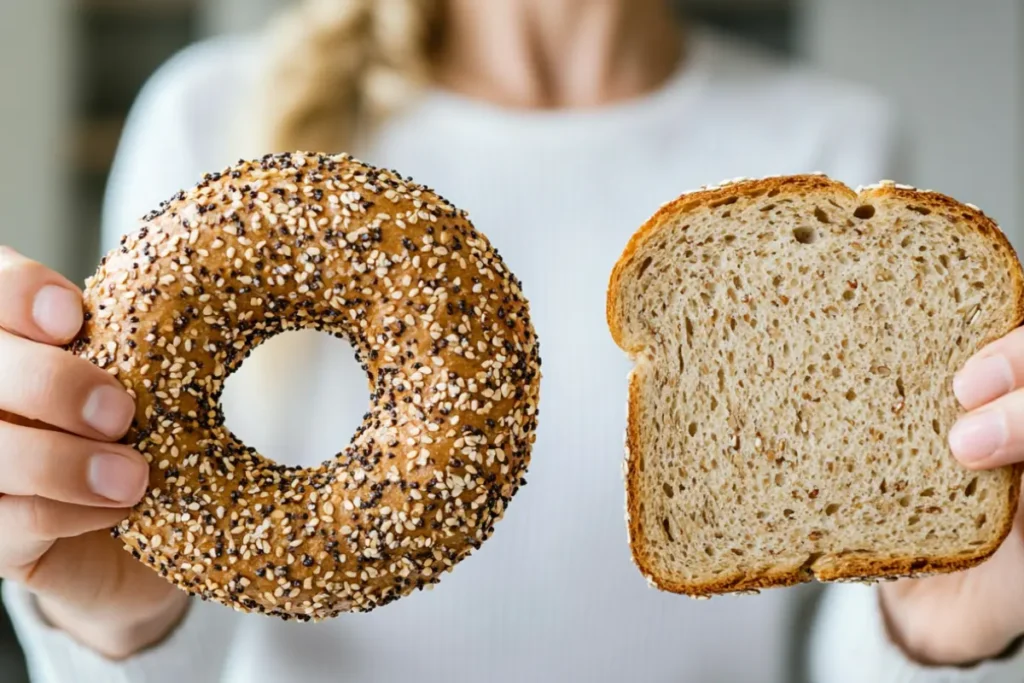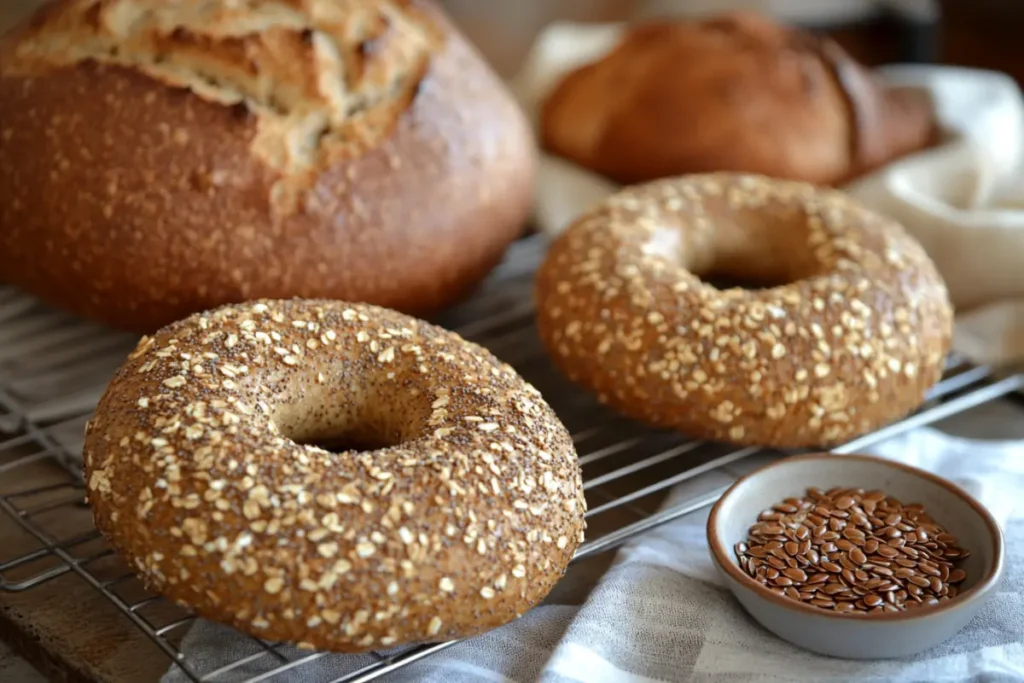Introduction
Bagels and bread have been breakfast staples for years, but have you ever wondered which one is healthier? Some people swear by a classic slice of whole wheat bread, while others love a chewy, dense multigrain bagel. The debate between bagels vs. bread isn’t just about taste—it’s about nutrition, calories, fiber, and even how they affect your blood sugar.
In this article, we’ll compare the two, breaking down their nutritional value, health benefits, and how they fit into different diets. Whether you’re trying to lose weight, manage blood sugar, or simply eat healthier, understanding the differences will help you make the best choice. By the end, you’ll have a clear answer to the question: Are bagels healthier than bread?
Introduction to Bagels and Bread
What Are Bagels and Bread?
Both bagels and bread are made from flour, water, yeast, and salt, but their textures and preparation methods differ. Bread is typically baked as a loaf, while bagels are boiled before baking, giving them their signature dense and chewy texture. They also tend to be higher in carbohydrates and calories compared to standard slices of bread.
Traditional bagels are round with a hole in the middle and are often made from refined white flour, but healthier options like whole grain bagels exist. Bread, on the other hand, comes in many varieties—sourdough, rye, whole wheat, and multigrain—each with different nutritional profiles.
Why Compare Bagels and Bread?
Many people assume bagels and bread are interchangeable, but they have key differences. If you’re watching your calorie intake, blood sugar levels, or trying to eat more fiber-rich foods, knowing which is healthier is essential.
Additionally, different types of carbohydrates affect the body in different ways. Some raise blood sugar quickly, while others provide slow-releasing energy, keeping you full longer. We’ll explore these aspects in detail to determine whether bagels or bread are the better choice for a balanced diet.
How This Article Will Help You Decide
By the end of this guide, you’ll understand:
- Which option is better for weight loss
- How different types of bread and bagels affect blood sugar
- The nutritional advantages and disadvantages of each
Now, let’s dive into the nutritional breakdown of bagels vs. bread to see how they compare!
Nutritional Breakdown: Bagels vs. Bread

Calories and Macronutrients: Which Has More?
When comparing bagels vs. bread, one of the biggest differences lies in calories and macronutrient composition. A standard bagel (around 100 grams) contains approximately 250-300 calories, whereas a slice of bread (about 30-40 grams) has only 70-100 calories. Since most people eat an entire bagel, that’s nearly three to four times more calories than a single slice of bread!
In terms of macronutrients, bagels and bread have similar carbohydrate and protein content per gram, but bagels tend to be higher in carbohydrates due to their denser nature. The higher calorie count of bagels can make portion control challenging, especially for those watching their weight.
Carbohydrates and Glycemic Index Differences
Both bagels and bread are high in carbohydrates, but how they impact blood sugar levels varies. The glycemic index (GI), which measures how quickly food raises blood sugar, is generally higher in white bagels than in whole grain bread. Refined bagels can cause a rapid spike in blood sugar, followed by a crash, leading to hunger shortly after eating.
Whole grain options like whole wheat bread or multigrain bagels have more fiber, which slows digestion and stabilizes blood sugar levels. If you’re looking for a more balanced energy source, opting for a high-fiber bread or a whole grain bagel is a smarter choice.
Protein Content: Which One Keeps You Fuller Longer?
Protein helps with satiety and muscle maintenance, and both bagels and bread contain moderate amounts. A plain bagel provides around 10-12 grams of protein, while a slice of bread has about 3-5 grams. However, since most people eat two slices of bread for a sandwich, the difference becomes less significant.
For a higher protein breakfast, consider pairing your bagel or bread with protein-rich toppings like cottage cheese, smoked salmon, or eggs. If you’re interested in making homemade high-protein breads, check out this recipe for cottage cheese flatbread.
Fat Content: Is There a Significant Difference?
Neither bagels nor bread contain much fat unless ingredients like seeds, butter, or cream cheese are added. A plain bagel has about 1-2 grams of fat, while regular bread has less than 1 gram. However, if you choose seeded bagels or whole grain breads, the healthy fats from flaxseeds, sunflower seeds, or chia seeds provide additional heart-friendly benefits.
Fiber Content: Which One Supports Digestive Health?
Fiber is essential for digestion and gut health, and whole grain bread generally contains more fiber per calorie than bagels. A slice of whole wheat bread provides about 2-3 grams of fiber, whereas a whole grain bagel has about 4-6 grams—but with significantly more calories.
For those aiming for better digestion and weight management, choosing whole grain bread or a high-fiber bagel is a smart move.
Health Benefits of Bagels and Bread
Whole Grain vs. Refined Grains: The Health Impact
Not all bagels and bread are created equal! The key difference in health benefits depends on whole grain vs. refined grains. Whole grain versions of both offer:
- More fiber to support digestion
- B vitamins for energy metabolism
- A lower glycemic index, preventing blood sugar spikes
Refined bagels, on the other hand, are often stripped of fiber and nutrients, making them less beneficial for overall health. If you love bagels, consider trying a pumpkin bagel recipe made with whole wheat flour for a healthier twist!
Vitamin and Mineral Content Comparison
Both bread and bagels contain essential vitamins and minerals, but whole grain bread typically offers:
- More iron, important for oxygen transport
- Magnesium, supporting muscle and nerve function
- Zinc, essential for immune health
White bagels may contain fortified nutrients, but they lack the natural fiber and antioxidants found in whole grain varieties.
Effect on Blood Sugar and Energy Levels
Are bagels healthier than bread for stable energy levels? It depends! Refined bagels digest quickly, causing blood sugar spikes and crashes, which can lead to fatigue and hunger. Whole grain breads or bagels, on the other hand, provide longer-lasting energy due to their higher fiber and nutrient content.
For sustained energy, opt for a whole wheat or sprouted grain bread, or pair a bagel with protein and healthy fats to slow digestion.
Heart Health: Which One Is Better for Cholesterol?
Whole grain breads and bagels contain soluble fiber, which helps lower LDL cholesterol (the “bad” cholesterol). Studies suggest that a high-fiber diet can reduce the risk of heart disease.
However, be mindful of store-bought bagels, which often contain more added sugar and sodium than bread. A better choice? A homemade whole wheat bagel or a sourdough bread, which contains natural probiotics that may support heart health.
Are Bagels Worse Than Bread for Weight Loss?

Portion Size: Why Bagels Are More Calorie-Dense
When it comes to weight loss, portion size plays a huge role. One of the main reasons bagels are often worse than bread for weight management is their calorie density. A standard bagel weighs around 100 grams and packs 250-300 calories, whereas a slice of bread is usually 30-40 grams with just 70-100 calories.
Most people eat an entire bagel in one sitting, which is equivalent to three to four slices of bread in calories. This makes it easy to consume more calories than intended, especially if paired with high-calorie toppings like cream cheese or butter.
Satiety Factor: Which One Helps You Eat Less?
Are bagels healthier than bread when it comes to keeping you full? Fiber and protein are the two biggest factors that influence satiety. Since bagels are denser and higher in carbs, they may cause a quicker spike in blood sugar, followed by a crash that leads to hunger sooner.
On the other hand, whole grain bread with added seeds or a protein-rich topping like eggs or avocado can keep you full for longer. Choosing high-fiber, whole grain options for either bagels or bread will help support weight loss by reducing cravings and preventing overeating.
Impact on Metabolism and Weight Gain
The glycemic index (GI) of bagels is higher than most bread types, meaning they can cause rapid spikes in blood sugar. Over time, frequent blood sugar spikes can lead to insulin resistance, which is linked to weight gain and metabolic disorders.
If you love bagels but want to lose weight, consider half a whole grain bagel with protein-rich toppings instead of eating a full bagel. You’ll still enjoy the flavor while keeping your calorie intake in check.
The Role of Ingredients and Processing

Artificial Additives and Preservatives in Commercial Bread and Bagels
Many store-bought bagels and bread contain preservatives, artificial flavors, and added sugar, which can impact health and digestion. Commercial bagels often have more sugar and sodium than regular bread, making them a less ideal choice for daily consumption.
Additionally, some brands use bleached white flour, which strips away essential fiber, vitamins, and minerals. Opting for organic or homemade whole grain bagels or bread made with minimal ingredients is a healthier choice.
Sourdough, Whole Wheat, and Multigrain Options: Which Is Better?
If you’re looking for healthier bread or bagel options, consider these choices:
- Sourdough bread: Naturally fermented, contains probiotics that support gut health.
- Whole wheat bagels: Higher in fiber and lower in sugar than traditional white bagels.
- Multigrain bread: Packed with seeds and grains that provide healthy fats and fiber.
Choosing whole grain or sourdough options can significantly improve nutritional value, making either bagels or bread a healthier choice depending on your dietary needs.
How Bagel Preparation Affects Nutritional Value
Did you know the way bagels are prepared can impact their health benefits? Traditional bagels are boiled before baking, which helps develop their dense texture. However, some mass-produced bagels are not boiled, making them more similar to processed white bread in terms of nutrition.
For a healthier homemade alternative, consider making pumpkin bagels using whole wheat flour. This way, you can control ingredients, reduce added sugar, and boost fiber content while still enjoying a delicious bagel.
Part 8: FAQs
To provide further clarity, here are answers to some frequently asked questions about are bagels healthier than bread?
1. Are bagels considered junk food?
Bagels are not necessarily junk food, but their nutritional value depends on the ingredients and portion size. A plain white bagel made with refined flour and added sugars is less nutritious than a whole wheat or multigrain bagel. If paired with healthy toppings like avocado, eggs, or almond butter, bagels can be part of a balanced diet. However, store-bought bagels often contain preservatives and added sugar, making them less ideal for daily consumption.
2. Which bread is the healthiest to eat?
The healthiest bread depends on your dietary needs. Some of the best options include:
- Whole grain or whole wheat bread – High in fiber, vitamins, and minerals.
- Sourdough bread – Contains natural probiotics that support digestion.
- Sprouted grain bread – Lower glycemic index and rich in nutrients.
- Rye bread – High in fiber and beneficial for blood sugar control.
If you’re looking for an alternative to bagels, consider trying whole grain sourdough or multigrain bread for a nutrient-dense and gut-friendly option.
3. Do bagels have more sugar than regular bread?
Yes, many commercial bagels contain more sugar than regular bread, especially flavored varieties like cinnamon raisin or blueberry bagels. A plain bagel can have 5-7 grams of sugar, whereas a slice of whole wheat bread typically contains 1-3 grams. If you want to reduce sugar intake, opt for homemade or whole grain bagels with no added sugars.
4. Is it okay to eat a bagel every day?
Eating a bagel every day is fine if you choose healthier versions and watch portion sizes. Instead of a large, refined-flour bagel, try a half of a whole grain bagel with protein-rich toppings to create a balanced meal. Also, consider rotating between bagels and fiber-rich bread options to maintain a varied and nutrient-dense diet.
Conclusion
So, are bagels healthier than bread? The answer depends on the type, ingredients, and portion size. Bagels tend to be more calorie-dense, while bread—especially whole grain varieties—often contains more fiber and nutrients per calorie.
If you’re looking for a healthier choice, opt for:
- Whole grain or sprouted grain bagels over refined white bagels
- Smaller portion sizes (half a bagel instead of a whole)
- Protein-packed toppings like eggs, salmon, or avocado to balance your meal
- Multigrain or sourdough bread for a lower glycemic index and gut-friendly benefits
Ultimately, both bagels and bread can fit into a healthy diet—just be mindful of ingredients, serving sizes, and added sugars. By making smarter choices, you can enjoy your favorite breakfast staples without compromising nutrition!

